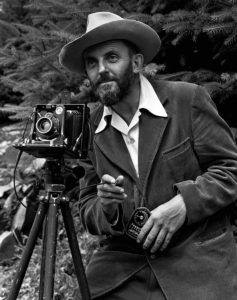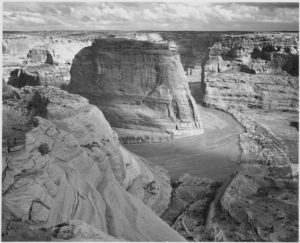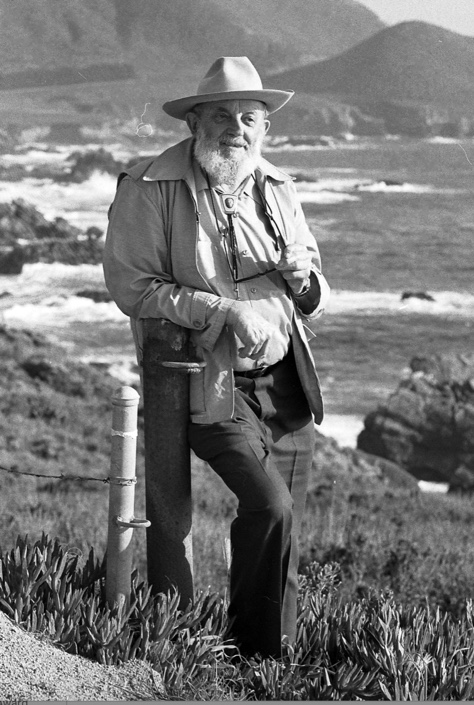Ansel Adams, the most famous nature photographer in history, was born on February 20, 1902 (died 1984), in San Francisco, California. The work of Ansel Adams is ubiquitous in the United States—in museums, government offices, calendars and pinned to the walls in college dorm rooms. No other photographer of nature has captured either the American landscape or the American consciousness as fully as Ansel Adams.

He was born into a rich family of western timber barons at a boom time in the American West. A particular boom—the 1906 San Francisco earthquake—left its mark on Adams. An aftershock of the earthquake threw him to the ground, breaking his nose. Not set correctly, his crooked nose was a visual signature throughout his life.
Adams was a difficult child, unsuccessful in school, unpopular with other children and, perhaps, what we would today call hyperactive. Consequently, after failing in several schools, he was home-schooled by his father and aunt. The piano became his primary friend—he taught himself to play and to read music. His skill grew to the level of a concert pianist, and he intended playing the piano as his career.
Nature was also his friend. He spent most days hiking the hills and coast around his home. In 1916, a trip to Yosemite totally captured his attention—and kept his attention for his entire life. The Sierra Nevada Mountains became his playground and his inspiration. Before long, he was photographing the mountains, learning a new trade that gradually attracted his full commitment and became his real career. It took some time before his artistic photography took off, so for many years he was a commercial photographer, snapping everything from portraits to fruit to retail catalogues.

As a young man, he became a member of the Sierra Club, participating in their high mountain activities and working for them, first as a trip counselor and then as photographer (learn more about the Sierra Club here). The Sierra Club gave Adams’s photographs their first public exposure—and neither he nor the club ever looked back. Along the way, Adams became not only a nature photographer, but a vigorous advocate for parks, wilderness and environmental protection. His photographs became the core of a 1930s book created as evidence of the need for more national parks. It worked, convincing President Franklin Roosevelt and his Secretary of Interior, Harold Ickes, to set aside Kings Canyon National Park in 1940 (learn more about Ickes here).
Aside from his environmental impact, Ansel Adams was a journeyman photographer of enormous skill. His technical talent was renown, as he perfected techniques for “straight photography”—letting the images speak for themselves, rather than being manipulated by the photographer or developer. As a dedicated black-and-white photographer, he marked the pinnacle of art photography before color images became the norm.

Adams worked and played hard. From excursions into the wilderness to marathons in the darkroom, he seldom took a day off. But he was equally known as a gracious host, a gregarious companion and, in general, the life of every party. He was a man of the American West, but spent long periods in New York as part of the art photography scene.
The true impact of Adams’s work, however, is unquestionably his vast landscapes of the American West. His signature photograph was taken only weeks before the Japanese attack on Pearl Harbor, on November 1, 1941—“Moonrise, Hernandez, New Mexico” (see more here). The moon is suspended in a dark sky over the spreading mountains and obliquely-lit town of Hernandez. He and companions were driving along the highway after a disappointing day of shooting around Santa Fe. He glanced to his left, saw the image, slammed on the brakes and rushed to take the shot just as the light was disappearing. Later he said, “Sometimes I do get to places just when God’s ready to have somebody click the shutter.”
Ansel Adams got to many places just when the shutter needed clicking, and our world is a more beautiful and inspirational place because of it.
References:
National Archives. Ansel Adams Photographs. Available at: https://www.archives.gov/research/ansel-adams. Accessed February 19, 2017.
Sierra Club. History: Ansel Adams. Available at: http://vault.sierraclub.org/history/ansel-adams/. Accessed February 19, 2017.
The Ansel Adams Gallery. Ansel Adams, Photographer. Available at: http://anseladams.com/ansel-adams-bio/. Accessed February 19, 2017.
